Been a few months since I did the introductory tutorials for A-Train PC Classic. Typically though, if something is not available yet it is because the function will be unlocked later on. So, quite possible that function will become unlocked later into the second tutorial scenario since the third and final tutorial delves firmly into the realm of business management aspects like going public on the stockmarket, etc.
Please have your tickets ready for inspection by the conductor and prepare to board today’s train, as our railroading adventure in All Aboard Tourism continues!
If there is one disadvantage to writing these as I play it’s that sometimes forecasting what can realistically be achieved for the next Let’s Play entry can be tough as the scenario goes on. Going to be some deviations from what I was expecting to do at the conclusion of part four. However, what we lose in one way we’re about to gain in another as I deviate into some aspects of the game that we haven’t even mentioned, let alone touched, yet.
Let’s Play All Aboard Tourism - Strategically using other people’s money to enrich ourselves…
Click to reveal...
Returning to Nagashirojo, we briskly resume where we left off in part four of Let’s Play All Aboard Tourism. On the agenda? Expanding our revenue by expanding our railway network southwards towards the map’s southern border and forging a connection with the mid-sized city of Komita. With just 1,197,130,000 Yen to our company’s name and a single track line stretching from Nagashirojo to Komita estimated to cost around the region of 3,000,000 Yen, it is time to head to the bank for a business loan.

The maximum amount of funds we can loan from the bank is determined by our company’s current assets and the bank’s trust in our company. Currently, the largest determinant of our loan limit is our company’s assets as our bank trust rating is just a measly one star. Based on our current assets the bank is willing to lend us up to a maximum of 2,287,700,000 Yen, spread across however many loans we decide to take out.
When negotiating our loan with the bank we can borrow money for a period of up to four years in length before having to pay it back in full, with interest on top of course. The length of the loan will influence the annual interest rate that the bank burdens us with. Interest rates are subject to change at the turn of the new year when the economic forecast for the upcoming year is presented, with a recession often liable to drop the interest rate by around three percent.
Any loan we apply for is subject to a 0.2% handling fee from the bank and therefore we must account for this if we ever apply for a loan whilst low on funds. The game’s UI helpfully details any handling fee, the amount of interest we are expected to pay over the duration of the loan, and the total repayment amount. Of course, we can repay any loans we have owing before the repayment date to lessen the amount of interest we will need to pay. However, bank fees apply for early repayment of any loan and thus a cost-benefit analysis should always be conducted to determine the cheapest course of action.
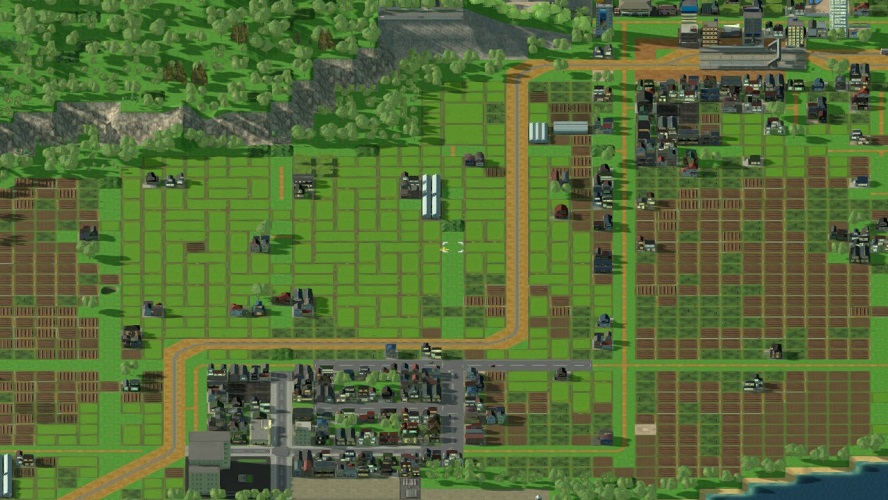
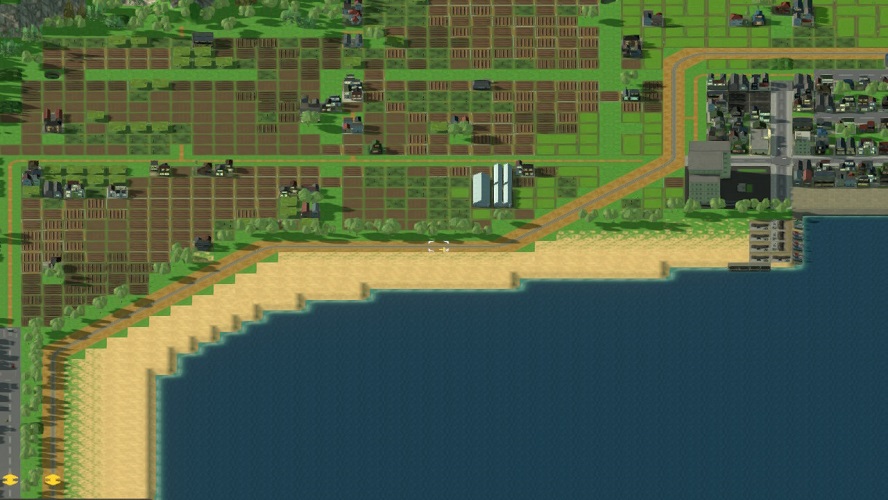
With a two-year loan of 2,287,700,000 Yen secured from the bank we now have 3,484,830,000 Yen at our disposal. Now that we have the capital required to proceed with our plans to building a railway line from Nagashirojo Station to Komita, let us begin! Due to the costs associated we will begin with just a single track line. Unfortunately, we currently lack the funds to begin construction of stations at the two towns situated along our chosen route. Therefore, these construction projects shall have to wait until we have more capital at our disposal.

Near Tomoto Station a small modification is also made to the double track line to allow for trains heading towards Hasuoka to be routed into the other platform. The reasoning behind this will become clear very soon.
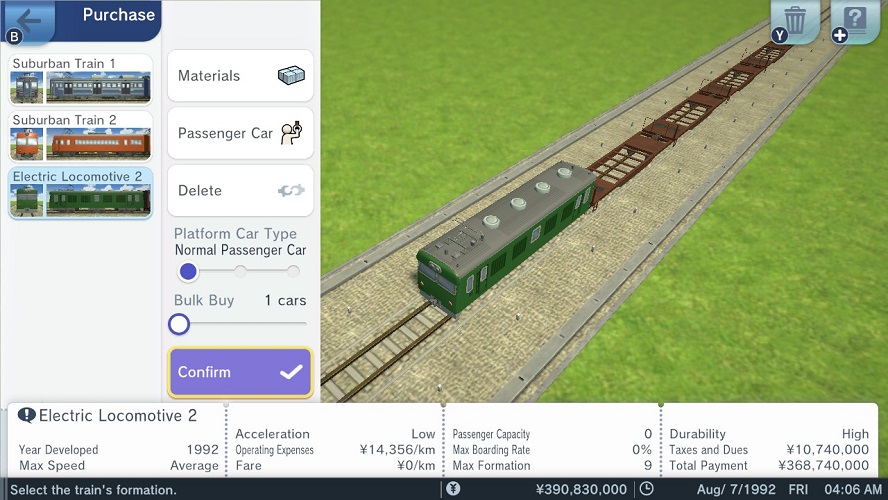
Next we purchase an Electric Locomotive with four carriages for the transport construction materials. This acquisition will almost exhaust the rest of our company’s remaining funds and leaves us light on funds. However, sometimes you have to spend money to make money and we expect this bold outlay of capital to quickly begin shoveling money into the company coffers.
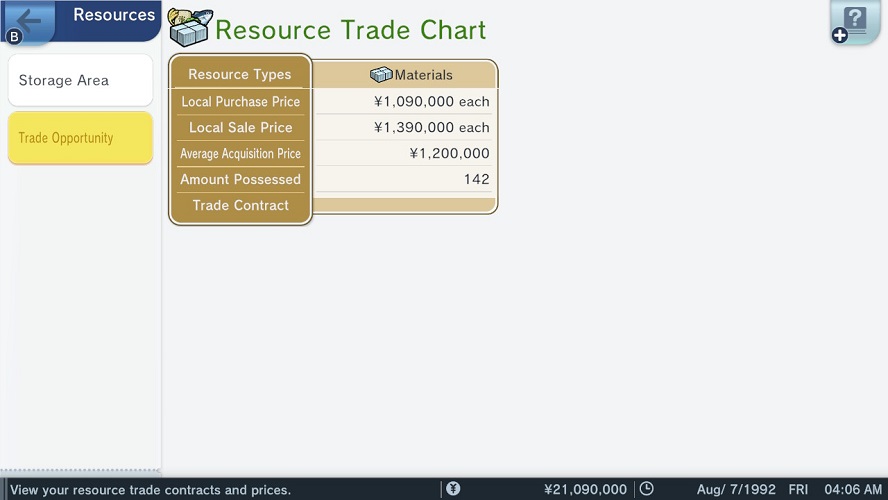
It is time for our company to diversify away from solely transporting passengers and to enter the freight market. Opening up the Resources menu we are going to proceed into the Trade Opportunity menu and assess the various purchase and sales orders on offer. We can see from the resource trade chart that Komita is currently placing several orders to buy construction materials, whilst Hasuoka is currently selling construction materials. By examining the list of trade contracts on offer we can see that Komita is currently offering, in many cases, roughly double the local sale price of construction goods.
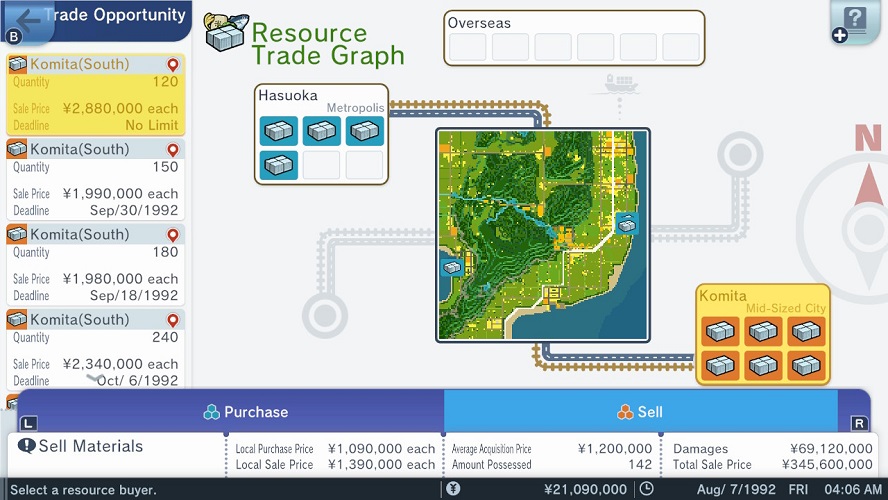
Therefore, we are going to cheaply purchase the construction materials being produced at Tomoto and then transport them from our storage facilities to Komita using our new goods train. Whilst the exact sale price may vary across the year, depending on the terms of the trade contracts we accept with Komita, we expect the transportation of construction goods to become a strong revenue stream for the company. To begin our new business venture we are going to enter into a contract to transport 240 construction materials to Komita by October 6th, 1992, at a sale price of 2,340,000 Yen per unit.
A word of warning though, failure to meet the obligations of our contract will grant Komita the right to seek damages. Thus, should we fail to transport 240 units of construction material to Komita by the deadline of October 6th, 1992 we will have to payout 69,120,000 Yen in damages for our breach of contract. Our company is very confident we can fulfill the terms of our contract with Komita in the time frame given, so this shouldn’t be a worry for us. If we were concerned about deadlines then we could have started out our new business venture by accepting the top-most contract on offer which ask for 120 construction materials and has no deadline assigned to it.
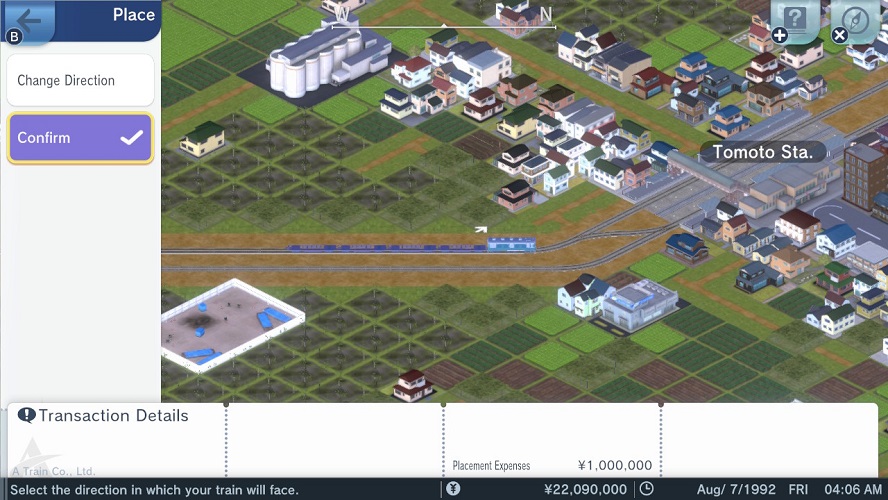
Now the purpose of our small track modification near Tomoto Station begins to become crystal clear. Since our freight train is going to be making two round trips from Komita to Tomoto and back we will be tackling the tricky task of coordinating the timetable of our Komita freight service with the last loop of our Hasuoka-Nagashirojo passenger service. However, since we’ll be basing the freight service out of Komita and only operating it between 8:15pm to 6:00am we’ll only be sharing the railway tracks with passenger services for a short window of time.
Yet it will still be a long enough time frame that we’ll need to be able to have our freight train pull into Platform 1 of Tomoto Station. That way the last two passenger services can freely use Platform 2 without experiencing any hold-ups or delays on their way back to Hasuoka. Thus, ensuring smooth operations for everyone sharing the railway tracks.
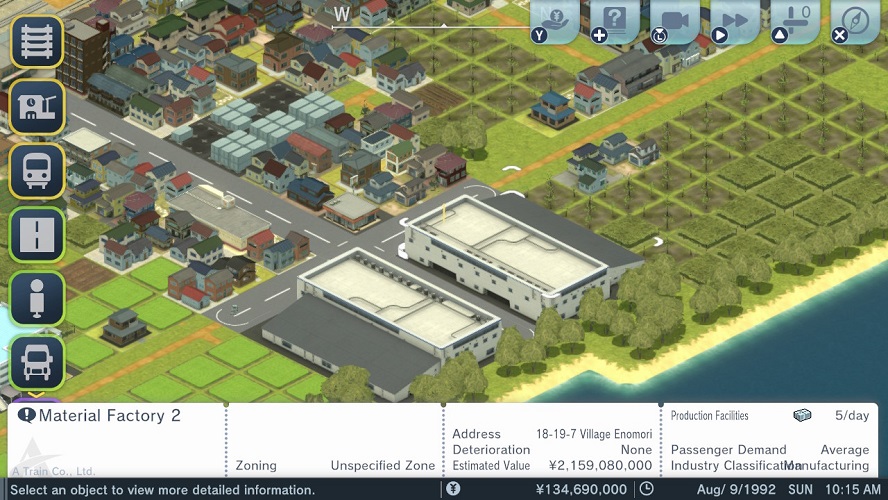
Pictured above you can see the two material factories responsible for creating the construction goods we are transporting to Komita. These two factories currently produce a total of ten construction materials a day (five each). The rate of production can rise and fall depending on factors such as economic conditions, the profitability of the factories, and whether they have any buildings nearby which boost their production (e.g. an administrative office).
Currently, these two factories are at the upper end of their production capabilities and are supplying our construction material storage yard with a steady supply of construction materials. Consequently, it does not take long for our freight service to Komita to begin filling up our coffers, generating us roughly 100,000,000 Yen within the space of two days.

During the early hours of August 25th we complete the terms of our first trade contract with Komita and so we enter into another one. This time the terms of the contract mean that we have 83 days to ship as many construction materials as possible to Komita for a sale price of 2,280,000 Yen per unit. A rather lucrative trade contract if we can maximise the supply of construction materials being fed into Komita. Looking at our funds we can see that our bank balance has been enriched greatly within a short period of time by our diversification into the freight business, rising to a total of 386,150,000 Yen.

Using the large stream of revenue unlocked by our entry into the freight business, we prepare for the next step of our business plan. Consequently, by September 7th we have constructed a train station at Nobusu and are in the process of upgrading the town’s road infrastructure to accommodate a planned bus route between Nobusu and Komita.
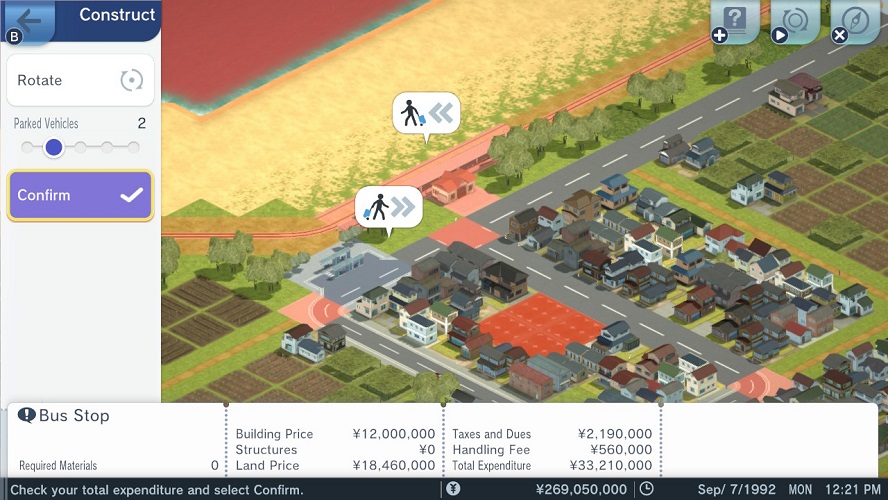
Since urban development is heavily influenced by passenger activity at stations we are going to turn Nobusu into a transfer hub for Komita tourists traveling to and from Nagashirojo Castle. We’ll bus tourists in from Komita, get them to spend some time in Nobusu, and then transport them by a connecting passenger train service to Nagashirojo Station. Something that wouldn’t happen if we just offered a direct train service from Komita to Nagashirojo.
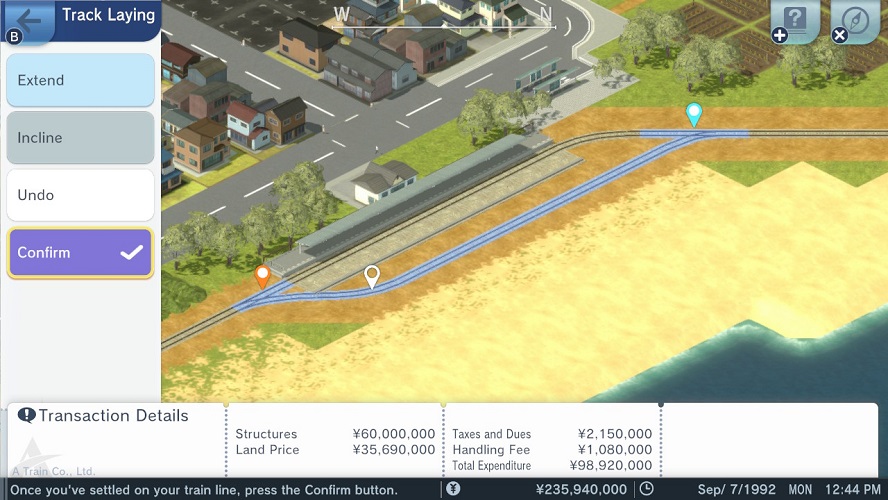
Since we will be parking our passenger train at Nobusu Station over the night we will also want to construct a simple passing loop for our freight service too. Then go into the operations route menu for our freight train to examine the settings of the new railway points to make sure that our freight train does indeed utilise our newly added passing loop at Nobusu Station.
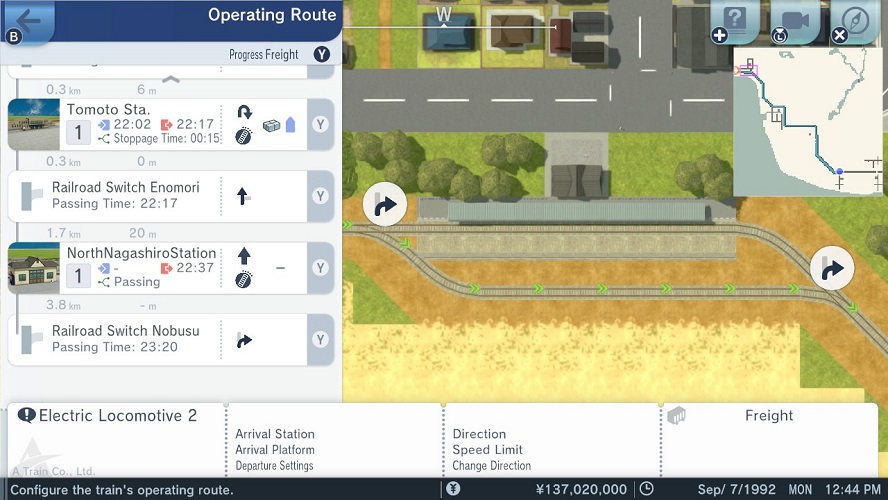
During September 11th we receive notice that we have reached the first of our objectives, as achieve our 200,000th annual tourist visit for the financial year. One completion condition successfully dealt with, now we just have to ensure that the region’s population hits 20,000 people within the assigned time frame and we’ll be assured of success. With 231,760,000 Yen currently residing in our company’s coffers we will have to continue advancing time for a while to be able to afford the rolling stock we want for our new passenger service.
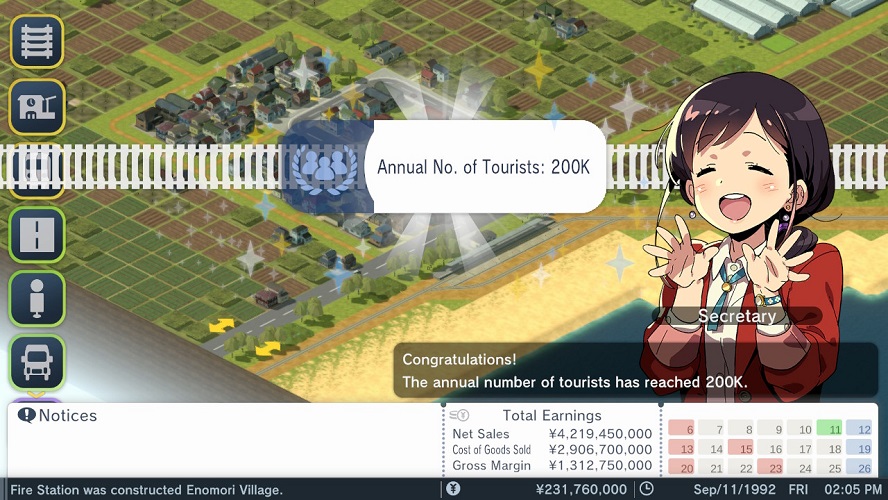
Which seems like an appropriate stopping point to conclude part five of Let’s Play All Aboard Tourism. I hope you will join me next time when we complete our plans to turn the town of Nobusu into a thriving tourist transfer hub. We’ll investigate buses and bus routes, establish the tourist route from Komita to Nagashirojo, assist in the urban development of Nobusu with subsidiaries, and discuss how we can become a property developer. Until the next time we met, I hope you have a safe journey aboard the A-Train!